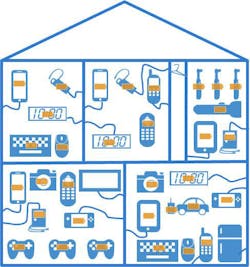This file type includes high resolution graphics and schematics when applicable.
In late 2008, the Wireless Power Consortium (WPC) began supporting an inductive-coupling standard. Since that moment, large companies competing in the portable-electronic-device (PED) market have been struggling to define an effective and universal standard to deliver power wirelessly to their devices (Fig. 1). Other standards associations, such as the Power Matters Alliance (PMA; an inductive-coupling standard) and Alliance for Wireless Power (A4WP; a magnetic-resonant standard) also have considerably large companies backing their efforts.
Related Articles
• SCMR Enables Efficient Wireless Power Transfer
• Alliance For Wireless Power Adopts Bluetooth Smart
• Wireless Power Receiver Simplifies Contactless Battery Charging
As recently as October of 2013, the IEEE Standards Association announced the IEEE Wireless Power and Charging Systems Working Group (WPCS-WG). Its goal is to control the standards for wireless power transfer (WPT) and help lead a unified front for developing WPT technologies starting with inductive coupling. With so much activity, many are trying to discern why there is such a struggle over WPT systems, the difference between all of the standards, and the impact of WPT on design engineers.
WPT was the brainchild of the wily scientist and showman, Nikola Tesla. His grandiose vision led him to build a WPT tower system that was meant to transmit energy across the globe in 1901. (Wardenclyffe Tower, which was located in Long Island, N.Y., was demolished in 1917.) Much has changed in the WPT world since 1901. The goal is no longer to transfer huge amounts of energy over vast distances with massive towers, but to transfer just enough energy to useful devices over very short distances.
Building a smart and efficient WPT infrastructure for highly diverse and numerous devices wasn’t economical until computers started fitting into pockets, as there was no demand or real use for such a system. With estimates of yearly PED sales at the hundreds of millions and growing, many companies with their fingers in the PED pie are trying to catch up with accessories and increasing accessibility for these devices. According to Mark Hunsicker, Senior Director of Wireless Power Solutions for Qualcomm, “From Qualcomm’s perspective, smartphones were the catalyst.”
As the computational capability of PEDs increases far beyond battery technology’s capacity to provide safe and adequate power with reasonable charging times, consumers and manufacturers of PEDs are looking for other ways to keep PEDs running. This conundrum has led to a scramble as top companies like Duracell, Procter & Gamble, Qualcomm, Samsung, LG, Energizer, Starbucks, Nokia, and hundreds of others either create their own standards or jump on board with other large companies’ standards. Meanwhile, the standards organizations—WPC, A4WP, and PMA—are vying for technology presence within PEDs to decide what standard will dominate.
Both the PMA and WPC standards operate in the hundreds-of-kilohertz range using two inductively coupled coils. Although they exhibit highly efficient energy transfer, they require close physical proximity with exact placement. A lack of interrupting objects also is required, as they can even heat metal objects in the near vicinity. The A4WP standard, Rezence, operates at 6.78 MHz within the Industrial, Scientific, and Medical (ISM) band and uses magnetic-resonant technology (Fig. 2). For a WPT system, magnetic resonance allows for efficient power transfer and position flexibility within several inches vertically/horizontal, through surface charging. These aspects permit incorporation into existing work surfaces. WPT systems also can provide higher power rates for hungrier devices.
This file type includes high resolution graphics and schematics when applicable.
Picking A Winner
This file type includes high resolution graphics and schematics when applicable.
Regardless of the electromagnetic (EM) method of energy transfer, the standards themselves include design guidelines for safety, interference, compliance, transmission, reception, antenna design, power, and telemetry. All of these technologies have functional examples and a few even have early product versions available. This year, all of them are looking to enlarge their presence in higher-volume arenas like smartphones, tablets, cars, and lounge/business areas like coffee shops.
Many companies that produce components for PEDs, such as Texas Instruments, are part of all of the WPT standards associations. They are betting on every standard so that they can capitalize on the market with whatever standard wins out. With the Chair of the WPCS-WG also being the Technical Director of the PMA, designers should expect a wide adoption of the PMA standards in large component manufacturers in the short term. The WPCS-WG also is allowing the next-generation implementation of WPT to embrace magnetic resonance as the technology matures. After all, magnetic resonance does possess many user-oriented benefits over inductive coupling. Right now, all of these standards focus on applications in which the device must physically be placed on or near a powering station and can only service a few devices simultaneously. Yet some companies are looking past current expectations into a more energy-accessible future, where PEDs are not the only devices looking to lose the cord.
For example, Hatem Zaine, CEO of Ossia, has spent the past 12 years developing COTA technology, which is geared toward putting “Star Trek” -level power availability in every home. The COTA system works on a very different principle of phased-array-focused energy transfer along the path of optimal efficiency. It delivers at least 1 W of constant power up to 30 ft. within the radius of the transmitter, with less power being available beyond 30 ft.
The transceiver/charger is roughly a subwoofer-sized mixture of a non-planar phased array with tens of thousands of elements and a computer dedicated to optimizing the long-distance energy transfer. A receiver is equipped with a 5-×-5-mm chip, which could easily be incorporated into phones, cases, batteries, smoke alarms, appliances, and more. That chip sends out a low-power omnidirectional signal, which the transceiver uses to take a 3D electromagnetic hologram of the room. It then decides upon the most efficient energy path to charge the receiver device.
Related Articles
• SCMR Enables Efficient Wireless Power Transfer
• Alliance For Wireless Power Adopts Bluetooth Smart
• Wireless Power Receiver Simplifies Contactless Battery Charging
The energy transmit path could include bouncing signals off walls, desks, tables or any other non-absorptive structure. This method intrinsically avoids sending RF power signals toward objects non-conducive to RF signal transfer, adding to the safety of the system. The RF hologram is generated at a rate of 100 times per second, which allows for easy avoidance of moving objects that would rather not absorb RF energy, like people and pets.
The COTA system stands out because it is not just designed to kick the common smartphone cord. Rather, its goal is to replace cords and charging concerns in all battery/low-powered household/commercial devices. This all sounds extremely space age and theoretical, but Ossia is demonstrating the technology at this month’s Consumer Electronics Show (CES) in Las Vegas, Nev. Following CES, the Ossia team is working on integrating the receiver technology so that it can be incorporated into AA and AAA batteries. According to Hatem, the market can expect COTA systems by 2015. Given the movement around the growing WPT industry, the product and solution landscape should already be quite diverse at that point.
This file type includes high resolution graphics and schematics when applicable.



